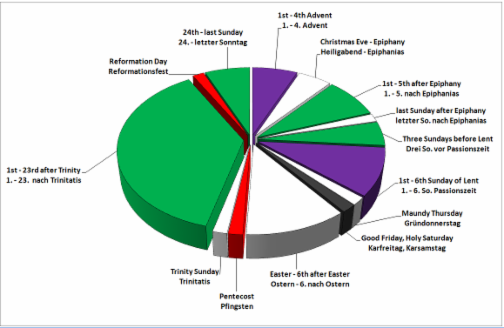The Christian Year
The church year describes the cycle of the church festivals within a year. It always starts on 1st Sunday of Advent (the first Sunday after the 26th of November) and ends with the Eternity Sunday. It is divided into three circles (seasons):
Christmas Season:
Advent, Christmas, Epiphany
Easter Season:
Lent, Holy Week (Maund Thursday, Good Friday), Easter, Ascension, Pentecost
Trinity Season:
Trinity season, Thanksgiving, Reformation Day, Eternity Sunday
Many festivals are not tied to a fixed date, but depend on the feast of Easter. Easter is celebrated every year on the Sunday following the first full moon of spring. According to this date, the duration of Epiphany, Ascension and Pentecost dates and the start and the duration of Trinity season is set.

The church colours
At the altar, on the pulpit and the lectern coloured cloths are mounted in our church, called frontals. The different colours symbolise the character of the Sunday. In the Lutheran church the liturgical colours are white, violet, green, red and black, and are associated with the festivals in church year.
White:
The white colour is associated with Jesus, to the joy of Christ and festive joy:
Christmas, Epiphany, Maundy Thursday, Easter and Ascension,Trinity
Red:
The red colour describes the Holy Spirit (fire), the Church and the Martyrs(blood):
Pentecost, Reformation, Confirmation
Purple:
The purple colour stands for the penance and preparation times:
Advent, Lent, Prayer and Repentance
Black:
In our tradition the black colour is always seen as a colour of mourning and lamentation and is used in our church only on:
Good Friday, Holy Saturday
Green:
The green colour means growing and maturing:
Epiphany, Trinity season
We will explain the colours in more in detail in future newsletters.
The Sunday
The church year connects the basic data of our faith to the course of the year. Our Lutheran tradition has chosen a Gospel, Epistle, weekly hymn, Psalm and liturgical colour for each Sunday in the church year.
The watchword for the week announces the ‘thought’ or theme of the day using a biblical sentence; the Gospel and Epistle readings then develop this theme. Their selection goes back to early Christendom. The hymn and the psalm of the week also complement the theme.
Normally the Introït (Psalm at the beginning of the service according to the lectionary) are verses from the psalm of the week.
The liturgical colours visualize the character of the day (refer to the graphic above).
Some Sundays have their names from the beginnings of the weekly psalms (in latin).
The ‘thoughts’ or themes of every Sunday will be explained in further articles.
Sundays in the 2nd half of the church year (after Trinity)
The word Trinitatis (Trinity) is composed from the Latin words ‘tri’ and ‘unitatis’ which means ‘Three in Unity’, expressing the theological dogma of the Trinity (the persons revealed in God the Father, Son and Holy Spirit). In German (Trinität) this is illustrated very often by forming a triangle around an eye. The festival of Trinity has been celebrated for app. 1000 years and for a long time there were different views in the churches on whether it should be generally celebrated or not. In any case, for the protestant churches the Sunday of Trinity has come to greater prominence than in the Roman Catholic church. It is the celebration of the creed, and thus the confession of faith was especially honoured during this day by singing and reading one of the two other confessions (which are very seldom spoken, but also belong to the confessional writings of the Lutheran church) the ‘Nicene Creed’ and the ‘Athanasian Creed’.
After the Sunday of Trinity the time of the church year starts which is often called the ‘non-festival time’. However, this not really true if we remember the different celebrations for St. John, St. Michael and Reformation Day. There are numerous apostles’ days and evangelists’ days in this time.
While in the first half of the church year we thought about the revelations of God’s acts in history, the time of Trinity celebrates the mysteries of the divine three-unity itself.
On the Sundays after Trinity we think about how the Christian congregation practices faith in this three-in-one God in her daily life.
The liturgical colour for the Sundays after Trinity is almost always green. The colour green symbolises hope, new life, growth and opportunity, learning something new. The time after Trinity is like a spiritual spring. Something new arises, but we do not know yet in which way it will be realised. The green liturgical colour asks us to be patient. God has his own time. He knows best for all of us, what we need, and what we should learn. However, we may be curious. What are we going to learn during the next months about God, about life and about other people? Life is full of lovely surprises if we keep our eyes open!
The divine service
is a very good opportunity for us to learn these things together, as a
congregation. How should we live as Christians? This is the main topic
of the services during this time of the church year. We also need to
experience, what does faith in God mean for me in my everyday life?
Which messages of the Bible are especially important for me? If I were
to write a creed in my own words, what would it contain? What have I
received in my life through faith?
I hope, that we all will have the opportunity to experience this blossoming green time in our lives and to really enjoy it.
Edmund Henry Newman